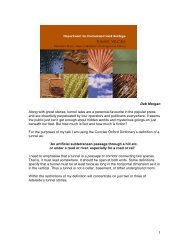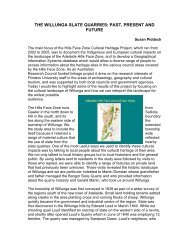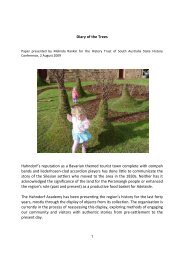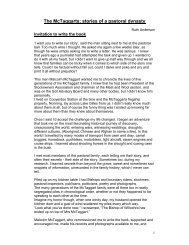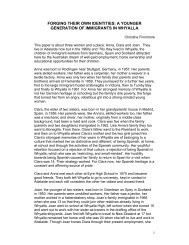Southward Bound Information - History SA
Southward Bound Information - History SA
Southward Bound Information - History SA
You also want an ePaper? Increase the reach of your titles
YUMPU automatically turns print PDFs into web optimized ePapers that Google loves.
(ii) messing and dining<br />
All food was cooked in a common galley, generally housed in a separated<br />
structure on deck. The fireplace was entirely enclosed in brickwork to reduce the<br />
danger of fire. The cook was nearly always assisted by a few migrants. In some<br />
ships through, the migrants prepared their own food - (either the mother in a family<br />
group or an elected or appointed person in a party) this was then taken up on deck<br />
to be cooked. Taking prepared dishes to be cooked was considered a man’s job.<br />
Single women were not permitted near the galley and so into the company of<br />
men. In the married quarters the task of preparing food fell mainly to the wives.<br />
The greatest range of botched dishes was undoubtedly produced by the single<br />
men.<br />
In fair weather the food stood some chance of arriving at the mess table warm. On<br />
a heavily rolling ship, in the cold of a northern winter, it seems more than probable<br />
it was absolutely frigid before it arrived at the table.<br />
Should the mess captain accidentally slip (for example) and lose his load (ie the<br />
food) overboard on the way back from the galley, everyone in that group would<br />
miss a meal. The ship only had to supply one issue of rations per meal. It was not<br />
the Captain’s concern if the rations did not reach their destination.<br />
(iii) water<br />
As fresh water was extremely scarce and had to last an unknown period, the<br />
careful traveller went to considerable trouble to husband supplies. What was left of<br />
the a ration after the cook had taken a share for the galley, was often bottled for<br />
later use. In 1840 the scale called for 3 quarts (approx 3 litres) of water per adult<br />
daily.<br />
After a week or two at sea the ‘fresh’ water often became so smelly that it could<br />
only be faced if diluted with a little wine or vinegar to kill the unpleasant odours.<br />
A downpour of rain brought people running with tubs, etc to collect any run off from<br />
the sails or awnings. Although the water tasted of old canvas it was much<br />
preferred to the ship’s drinking water.<br />
Even with the water supply as it was, it is common to read of those who required<br />
less water selling a bottle or more to those not so careful or more thirsty.<br />
SUMMARY:<br />
A descriptive passage from Charlwood’s THE LONG FAREWELL<br />
Having heard the essentials of steerage accommodation we can visualise every<br />
peg with its smocks and coats and headgear hanging from it every shelf laden with<br />
such home food stuffs as the passengers were able to bring, the wide table strewn<br />
with metal mugs and plates and cutlery each bunk occupied by men women and<br />
children some sitting some lying then we can imagine the whole in motion rolling



